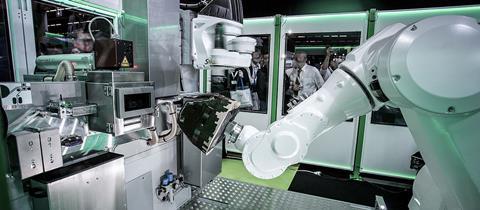Efficient production of high-strength lightweight components
The Fiber Patch Placement (FPP) systems developed by a Bavarian technology company constitute a step change in additive manufacturing. Thanks to high-performance robotics, the process has the potential to revolutionize the series production of geometrically complex lightweight parts in the automotive industry.
Weight reduction is a top priority in vehicle production. Safety equipment and luxury features have been pushing unladen weights up and up in recent years. In order to reduce fuel consumption and pollutant emissions, manufacturers are now endeavoring to reverse this trend. Lightweight construction is in great demand, yet the relevant materials and manufacturing processes will only find their way into the factories if they pass the test of cost efficiency.
SOLUTION
Additive manufacturing Fiber Patch Placement (FPP)
The pioneering additive manufacturing process known as Fiber Patch Placement (FPP) constitutes a major breakthrough. FPP is a layering method in which a three-dimensional mold, positive or negative, is layered with carbon fiber strips, the so-called patches. The part is built up from individual adhesive fiber strips.
Just how fast, efficient and cost-effective Fiber Patch Placement can be in practice is already being shown by SAMBA Pro which has been developed by the Taufkirchen-based company Cevotec. This fully automated production line is equipped with two Stäubli robots. Between them, the ultra-nimble TP80 FAST picker and the six-axis TX200 bring a total of ten robot axes to bear on the free positioning of the patches.
And this is how Fiber Patch Placement works. Station 1 is where a continuous carbon fiber strip is fed to the automated cutting machine. Here, an ultra-precise laser slices off shorter lengths to be used as patches. In the next step, the special vacuum gripper on the FAST Picker lifts the carbon fiber patch from the conveyor belt and presents it to a camera system which determines the precise position and orientation of the patch held by the gripper. The TP80 then sticks the patch on. While handling the patch, the gripper applies heat, thereby activating the adhesive side to ensure that it is firmly attached. The task of the large six-axis TX200 is to position the mold below the TP80 with speed and accuracy so that it is ready to receive the patches.
CUSTOMER USAGE
By individually matching the fiber orientation of each patch to the stresses within the component, mechanical properties can be increased by up to 150 percent. Another advantage is the significant weight reduction, which can be more than 50 percent in some components. In addition, the process scores highly in terms of maximum material utilization, i.e. 100 percent. Fiber Patch Placement thus represents a major development in the volume batch production of complex high-performance parts.
“The performance of the Stäubli robots is crucial for the entire process,” says Cevotec CTO Felix Michl. “Thanks to the high dynamics of the TP80 in particular, we are able to achieve cycle times that facilitate mass production. The element of speed brings flexibility to Fiber Patch Placement and makes this technology suitable for series production on both a small and a large scale.”







































